Influence of Guide Vane Profile Change on Draft Tube Flow Characteristics of Water Pump Turbine
Abstract
:1. Introduction
2. Design Process and Model Building
2.1. Activity Guide Leaf Design Process
2.2. Mesh Classification and Model Building
2.3. Introduction to the Test Rig and Numerical Calculation Methods
Introduction to the Test Setup and Conditions
2.4. Turbulence Model and Boundary Conditions
2.5. Calculation Results and Analysis
2.5.1. Reliability Verification
2.5.2. Reliability Analysis of Pressure Pulsation
3. Results
3.1. Draft Tube Local Flow Line Analysis
3.2. Variation of Vortex Band Morphology in the Draft Tube under Different Guide Vane Airfoil Types
3.3. Analysis of Turbulent Energy of Draft Tube at Different Moments with Different Guide Vane Airfoil Types
3.4. Analysis of Pressure Pulsation of Draft Tube under Different Guide Vane Airfoil Types
4. Conclusions
- (1)
- Comparing the flow diagrams of the draft tube before and after the modification of the movable guide vane, it is found that the swirl area of the curved elbow section and the diffusion section of the draft tube is reduced after the modification. Further analysis of the vector diagrams of the dt1 and dt2 sections shows that the direction and velocity of the water entering the draft tube area (dt1 section) have changed due to the change in the airfoil shape, and the axial outflow has also increased, reducing the concentrated impact of the water in the inlet area on the wall of a certain area. And combined with the top view of the two cross-sections found that the interference of the return flow to the normal flow of water in the draft tube is reduced, increasing the outflow of the turbine. The combined effect caused a reduction in the swirl region of the draft tube. The instability of the unit is reduced.
- (2)
- The vortex belt evolution diagram of the draft tube before and after the modified movable guide vane can be found that the modified guide vane changes the direction of vortex belt rotation forward in a period of time, reduces the speed of rotation near the wall of the draft tube, and reduces the vortex density inside the vortex. t1 to t4 time to the wall of the bent elbow section and the middle of the diffusion section vortex belt accelerates the development of rupture, which makes the turbine operation more stable and reduces the risk of fatigue damage to the unit.
- (3)
- The change of turbulent energy before and after the modification of the movable guide vane shows that the change of the airfoil shape causes the change of the direction of the vortex belt in the wake pipe and accelerates the development of the vortex belt collapse, which reduces the turbulent energy near the vortex of the wake pipe. It is calculated that the change in airfoil shape improves the energy return coefficient of the draft tube by 0.69, 0.72 and 0.75 for Q11 = 0.83, 0.66 and 0.3 (m3·s−1), respectively, which improves the energy recovery level.
- (4)
- By analyzing the pressure pulsation of the tailwater pipe area section before and after the modification, the main frequency of the straight cone section of both tailwater pipes corresponds to the vortex belt rotation period, and the pulsation of the tailwater pipe area is not stable. The modification reduces the draft tube vortex belt rotation and tailwater pipe wall collision reduces the pulsation intensity, which leads to a lower value of pressure pulsation fluctuation (6–9%) and improves the threshold of stable operation of the reversible turbine.
Author Contributions
Funding
Institutional Review Board Statement
Informed Consent Statement
Data Availability Statement
Conflicts of Interest
References
- Li, W.; Li, Z.; Qin, Z.; Yan, S.; Wang, Z.; Peng, S. Influence of the solution pH on the design of a hydro-mechanical magneto-hydraulic sealing device. Eng. Fail. Anal. 2022, 135, 106091. [Google Scholar] [CrossRef]
- Li, L. Review and outlook of pumped storage power plant design. Hydroelectricity 2010, 36, 1–2. [Google Scholar]
- Yu, J.; Cai, S.; Zheng, L.; Sun, J. Experimental analysis of pressure pulsation and velocity distribution of draft tube of Francis turbine. J. Huazhong Inst. Technol. 1981, 6, 63–70. [Google Scholar] [CrossRef]
- Chang, J. Similar law of unsteady periodic water flow in draft tube of Francis turbine. J. North China Inst. Water Resour. Hydropower 1981, 2, 18–28. [Google Scholar] [CrossRef]
- Cheng, L. On the hydraulic vibration of mixed-flow turbine. J. Huazhong Inst. Technol. 1981, 6, 57–62. [Google Scholar] [CrossRef]
- Kubota, T.; Matsui, H. Cavitation characteristics of forced vortex core in the flow of a francisturbine. Fuji Electr. Rev. 1972, 18, 102–108. [Google Scholar]
- Kubota, A.; Kato, H.; Yamaguchi, H. A new modeling of cavitating flow: A numerical study ofunsteady cavitation on a hydrofoil section. J. Fluid Mech. 1992, 240, 59–96. [Google Scholar] [CrossRef]
- Nishi, M. Surging Characteristics of Conical and Elbow Type Draft Tubes. In Proceedings of the 12th IAHR Symposium on Hydraulic Machinery and Systems, Stirling, UK, 27–30 August 1984; pp. 272–283. [Google Scholar]
- Jacob, T.; Prenat, J.E. Francis turbine surge: Discussion and data base. In Proceedings of the 18th IAHR Symposium, Valencia, Spain, January 1996. [Google Scholar]
- Lliescu, M.S.; Ciocan, G.D.; Avellan, F. Analysis of the cavitating draft tube vortex in a Francis turbine suing Particle Image Velocimetry measurements in two-phase flow. ASME J. Fluids Eng. 2008, 130, 021105-1-10. [Google Scholar]
- Wu, G.; Wei, C.; Tan, Y.; Zhang, K. The Effect of Gatage on the Pressure Fluctuation in Draft Tube of Francis Turbine. J. Huazhong Univ. Sci. Technol. 1999, 9, 27–29. [Google Scholar]
- Konstantinov, A.; Staroselsky, I.; Orszag, S.A.; Yakhot, V. Renormalization Group-Based Transport Modeling of Premixed Turbulent Combustion: I. Incompressible Deflagration Model. J. Sci. Comput. 1998, 13, 229–252. [Google Scholar] [CrossRef]
- Kurenkov, A.; Oberlack, M. Modelling Turbulent Premixed Combustion Using the Level Set Approach for Reynolds Averaged Models. Flow Turbul. Combust. 2005, 74, 387–407. [Google Scholar] [CrossRef]
- Gao, Z.; Deng, J.; Ge, X. Numerical simulation of three-dimensional unsteady vortex rope turbulent flow occurred to the draft tube of a Francis turbine. J. Hydraul. Eng. 2009, 40, 1162–1167. [Google Scholar]
- Zhang, C.; Diao, W.; You, J.; Xia, L. Numerical analysis of dynamic characteristics 0f the vortex rope in a francis turbine with splitter blades. J. Huazhong Univ. Sci. Technol. 2017, 45, 66–73. [Google Scholar]
- Li, Q.; Zhao, C.; Long, S.; Quan, H. Study on the evolution of draft tube vortex band under flyaway condition of reversible hydraulic turbine. Vib. Shock. 2019, 38, 222–228. [Google Scholar] [CrossRef]
- Fu, X.; Li, D.; Wang, H.; Zhang, G. Investigation on the fluctu ation of hydraulic exciting force on a pump-turbine runner during the load rejection process. In Proceedings of the IOP Conference Series: Earth and Environmental Science, Beijing, China, 16–19 November 2017; p. 012101. [Google Scholar]
- Gao, Z.; Zhu, W.; Meng, L.; Zhang, J. Experimental Study of the Francis Turbine Pressure Fluctuations and the Pressure Fluctuations Superposition Phenomen on Inside the Runner. J. Fluids Eng. 2017, 140. [Google Scholar] [CrossRef]
- Zhang, Y.; Zheng, X.; Li, J.; Du, X. Experimental study on the vibrational perform ance and its physical origins of a prototype reversible pump turbine in the pumped hydro energystorage power station. Renew. Energy 2019, 130, 667–676. [Google Scholar] [CrossRef]
- Zhang, Y.; Chen, T.; Li, J.; Yu, J. Experimental Study of Load Variations on Pressure Fluctuations in a Prototype Reversible Pump Turbine in Generating Mode. J. Fluids Eng. 2017, 139, 074501–074504. [Google Scholar] [CrossRef]
- Favrel, A.; Müller, A.; Landry, C.; Yamamoto, K.; Avellan, F. Study of vortex zone evolution and pressure pulsation in draft tube under upstream disturbance conditions. Exp. Fluids 2015, 56, 215. [Google Scholar] [CrossRef]
- Chen, M. Study on the Correlation Mechanism Between Flow Field Structure of Mixed-Flow Rotor Outlet and Pressure Pulsation Characteristics of Draft Tube. Master’s Thesis, Xi’an University of Technology, Xi’an, China, 2021. [Google Scholar] [CrossRef]
- Li, C.; Pu, F.; Yang, J.; Wu, C.; Zhang, X.; Yang, H.; Yu, R. Analysis of the effect of different velocity angles of draft tube inlet on its internal flow field. Yunnan Hydropower 2022, 38, 58–62. [Google Scholar]
- Wu, W.; Li, L.; Lv, R.; Yu, A. Research on pressure pulsation characteristics of pump turbine draft tube under different working conditions and improvement measures. Hydropower Pumped Storage 2021, 7, 11–19. [Google Scholar]
- Yan, W.; Yang, J.; Zhang, Z.; Zeng, Y.; Yang, J. Effect of draft tube cavity vortex on the stability of pumped storage power plant system. J. Hydropower Gener. 2022, 41, 113–121. [Google Scholar]
- Ma, Y.; Qian, B.; Feng, Z.; Liu, X.; Wang, B. Influence of cross-beam holes on the internal flow characteristics of the draft tube of axial-flow turbine. People’s Yellow River 2021, 43, 122–124. [Google Scholar]
- Yang, J.; Zhang, X.; Li, H.; Li, Y. Influence of draft tube deflector on the internal flow of centrifugal pump as a permeable level. Hydraul. Pneum. Seals 2021, 41, 60–60,63. [Google Scholar]
- Yang, L.; Yan, C.; Zhang, J.; Deng, Z. The effect of draft tube with rectifier on its internal flow pattern. J. Drain. Irrig. Mach. Eng. 2018, 36, 124–128,135. [Google Scholar]
- Rong, L. Hydrodynamic Analysis and Airfoil Optimization of Turbine Blades. Master’s Thesis, Harbin Engineering University, Harbin, China, 2006. [Google Scholar]
- Li, Q.; Ma, Q.; Xin, L. Effect of radius of guide vane head circle on hydraulic characteristics of water pump turbine. J. Huazhong Univ. Sci. Technol. (Nat. Sci. Ed.) 2022, 50, 94–100,115. [Google Scholar] [CrossRef]
- Zeng, H.; Li, Z.; Li, D.; Chen, H.; Li, Z. Vortex Distribution and Energy Loss in S-Shaped Region of Pump Turbine. Front. Energy Res. 2022. [Google Scholar] [CrossRef]
- Li, Z.; Li, W.; Wang, Q.; Xiang, R.; Cheng, J.; Han, W.; Yan, Z. Effects of medium fluid cavitation on fluctuation characteristics of magnetic fluid seal interface in agricultural centrifugal pump. Int. J. Agric. Biol. Eng. 2021, 14, 85–92. [Google Scholar] [CrossRef]
- Chen, X. Study on the Influence of Water Pump Turbine Guide Vane Wing Shape on “S” Characteristic. Master’s Thesis, Lanzhou University of Technology, Lanzhou, China, 2020. [Google Scholar] [CrossRef]
- Chen, A. Research on Vortex Band Characteristics of Water Pump Turbine Draft Tube and Improvement Method. Master’s Thesis, Harbin Institute of Technology, Harbin, China, 2017. [Google Scholar]



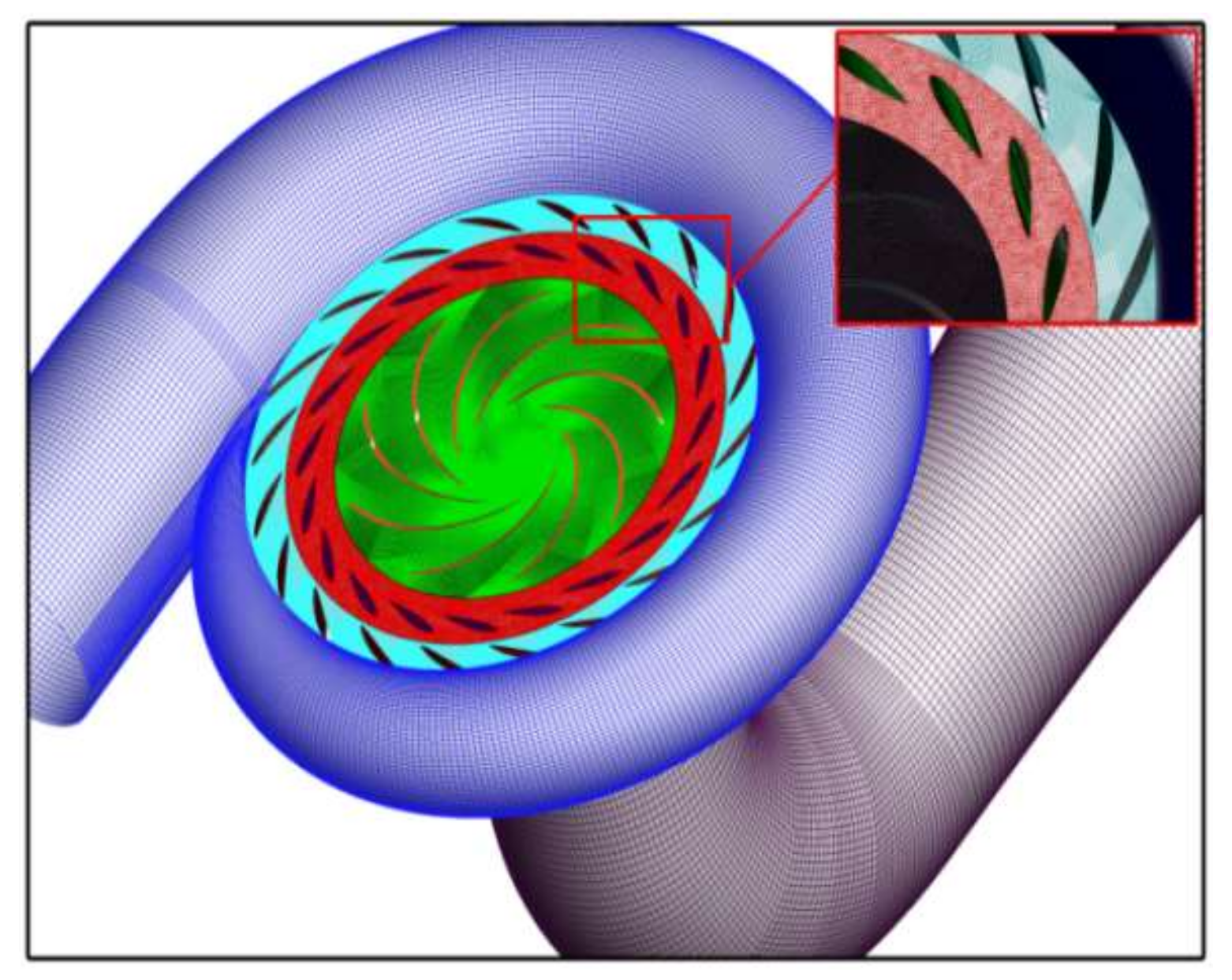
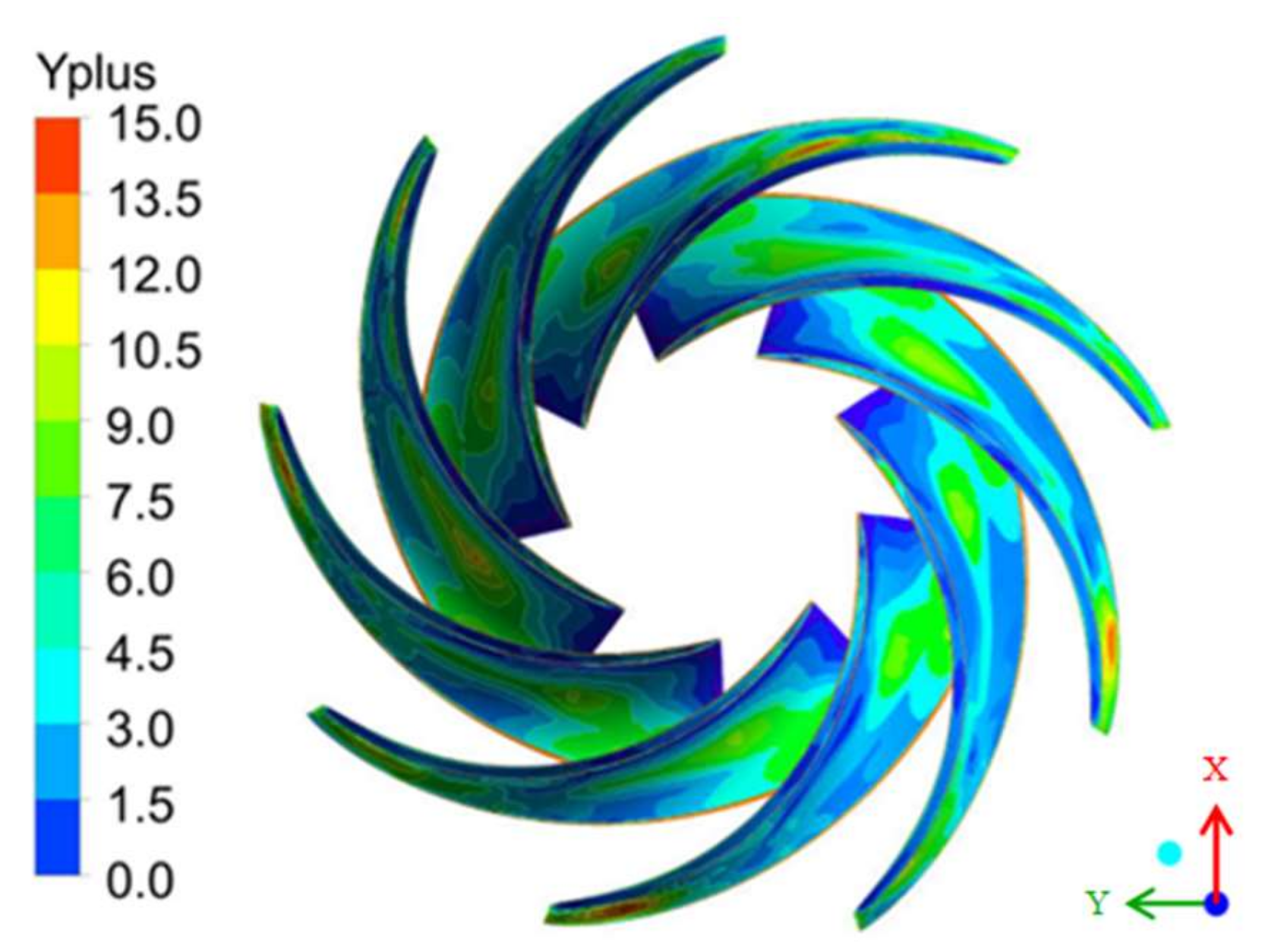

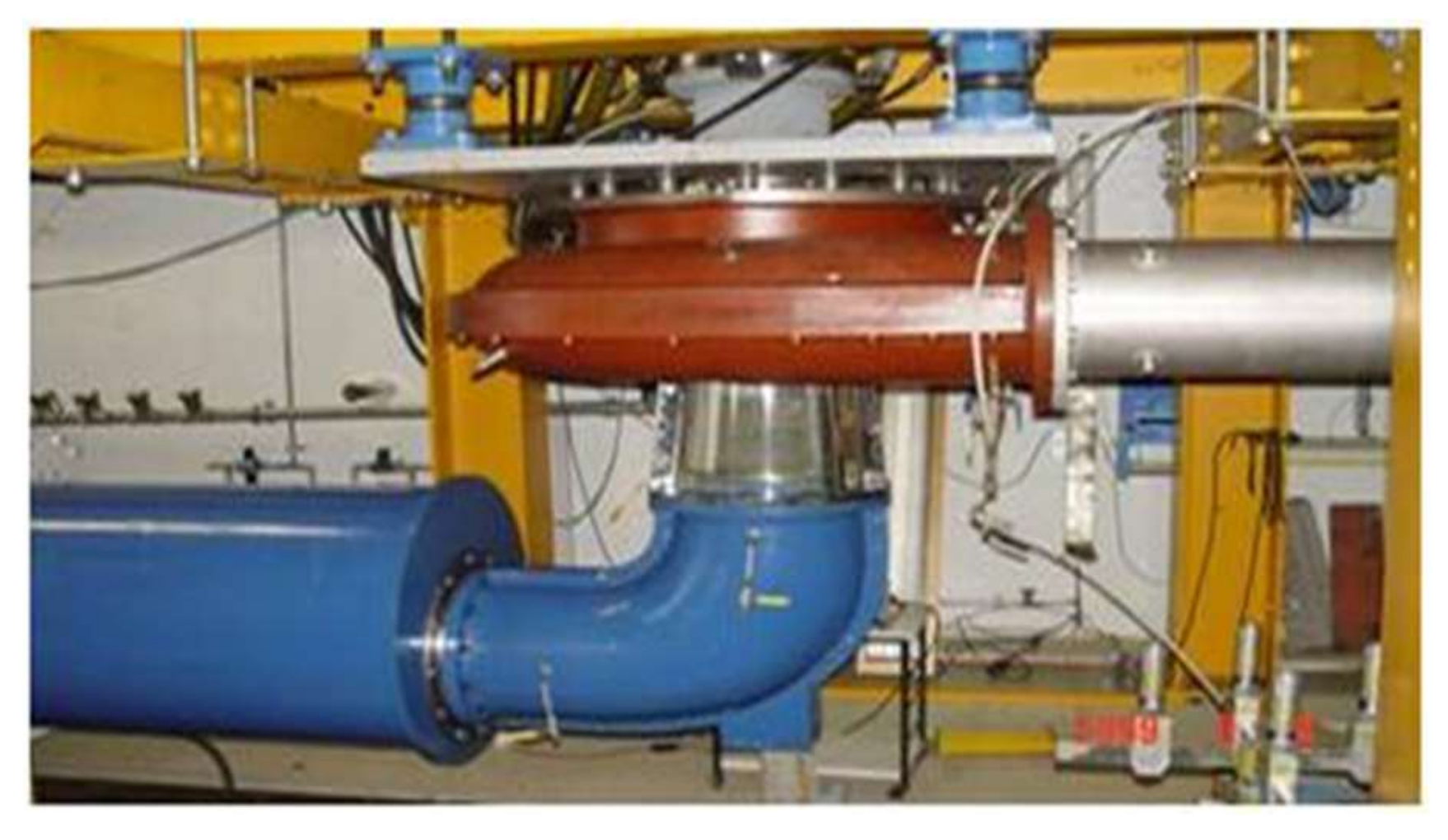
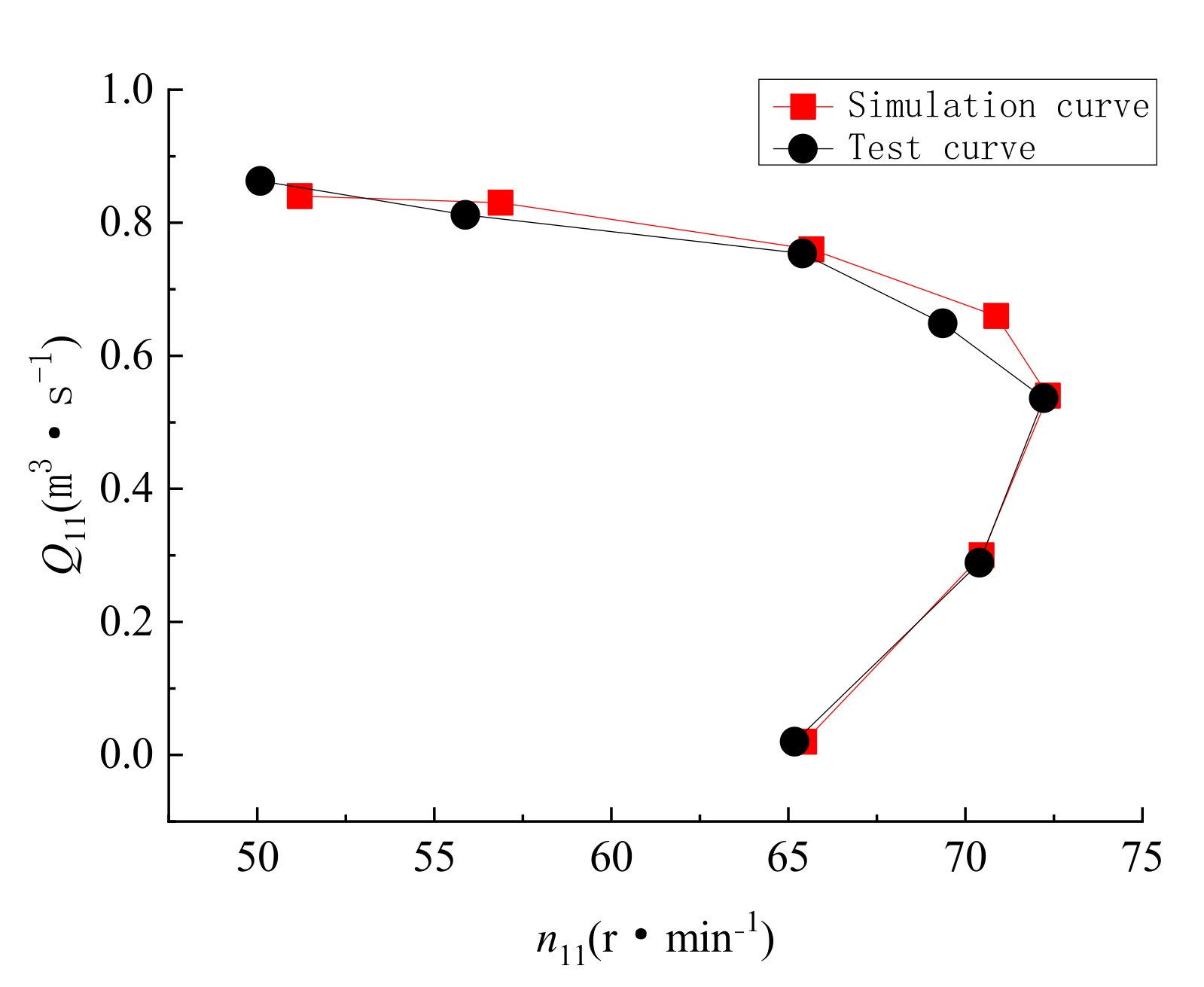

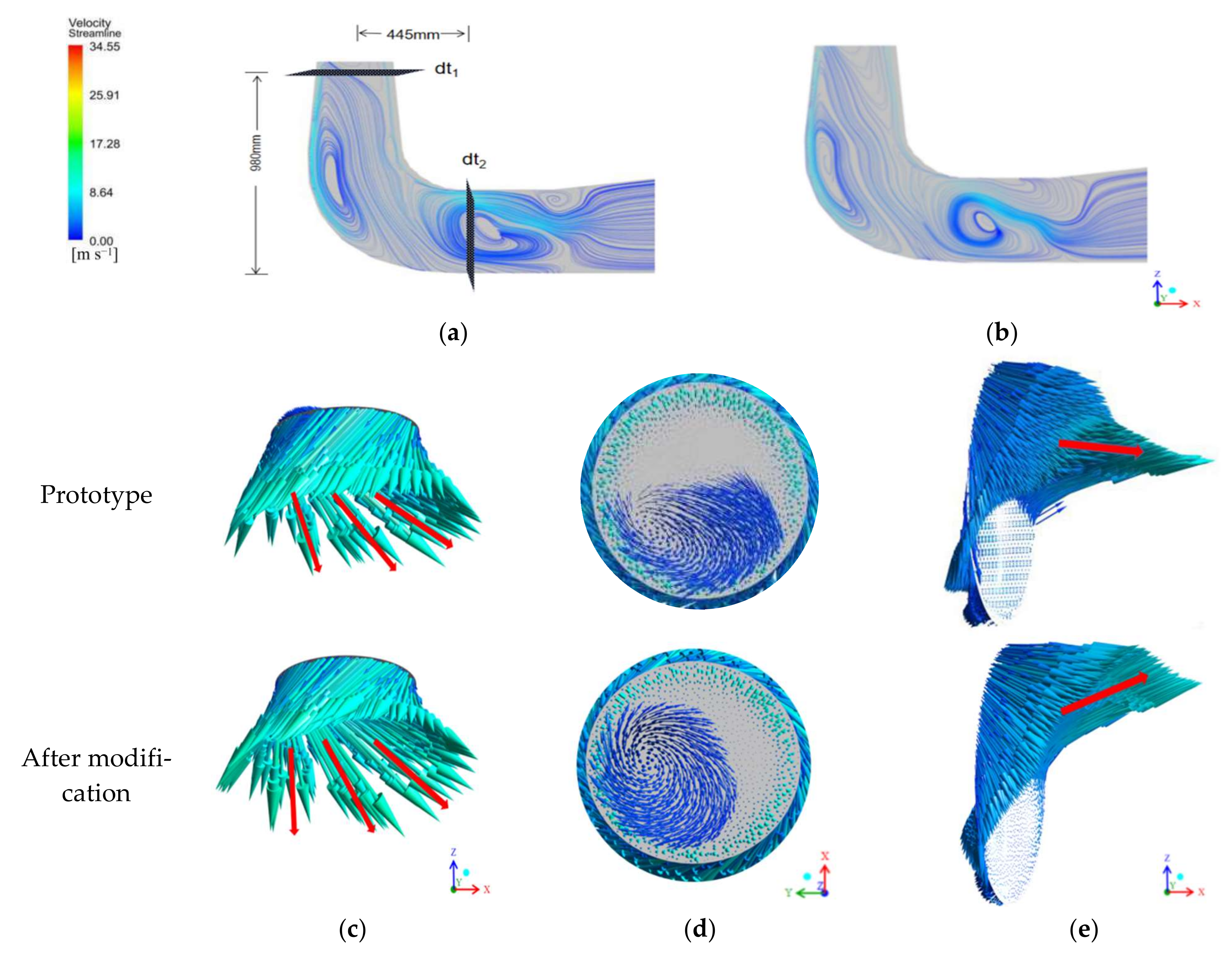
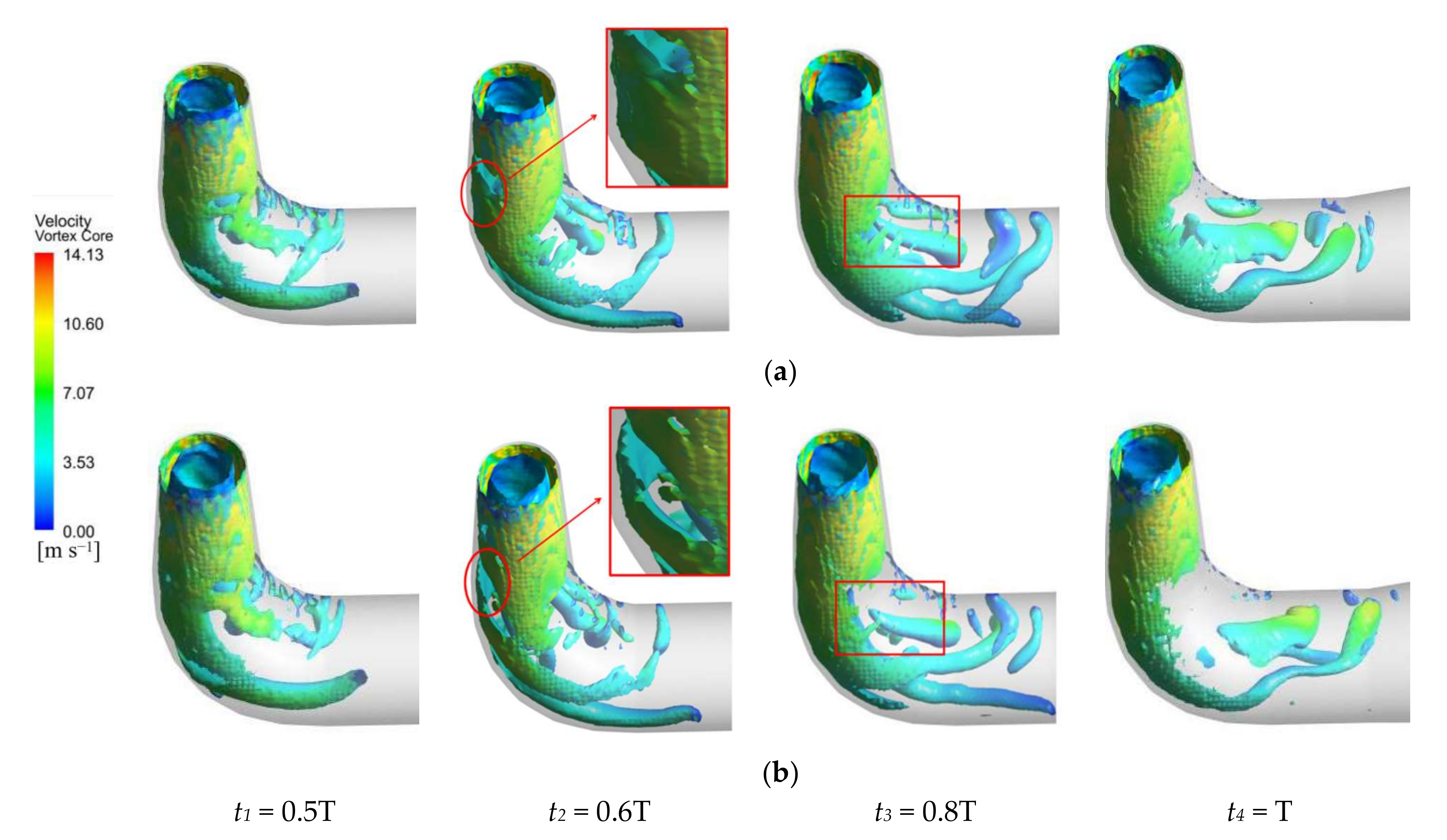

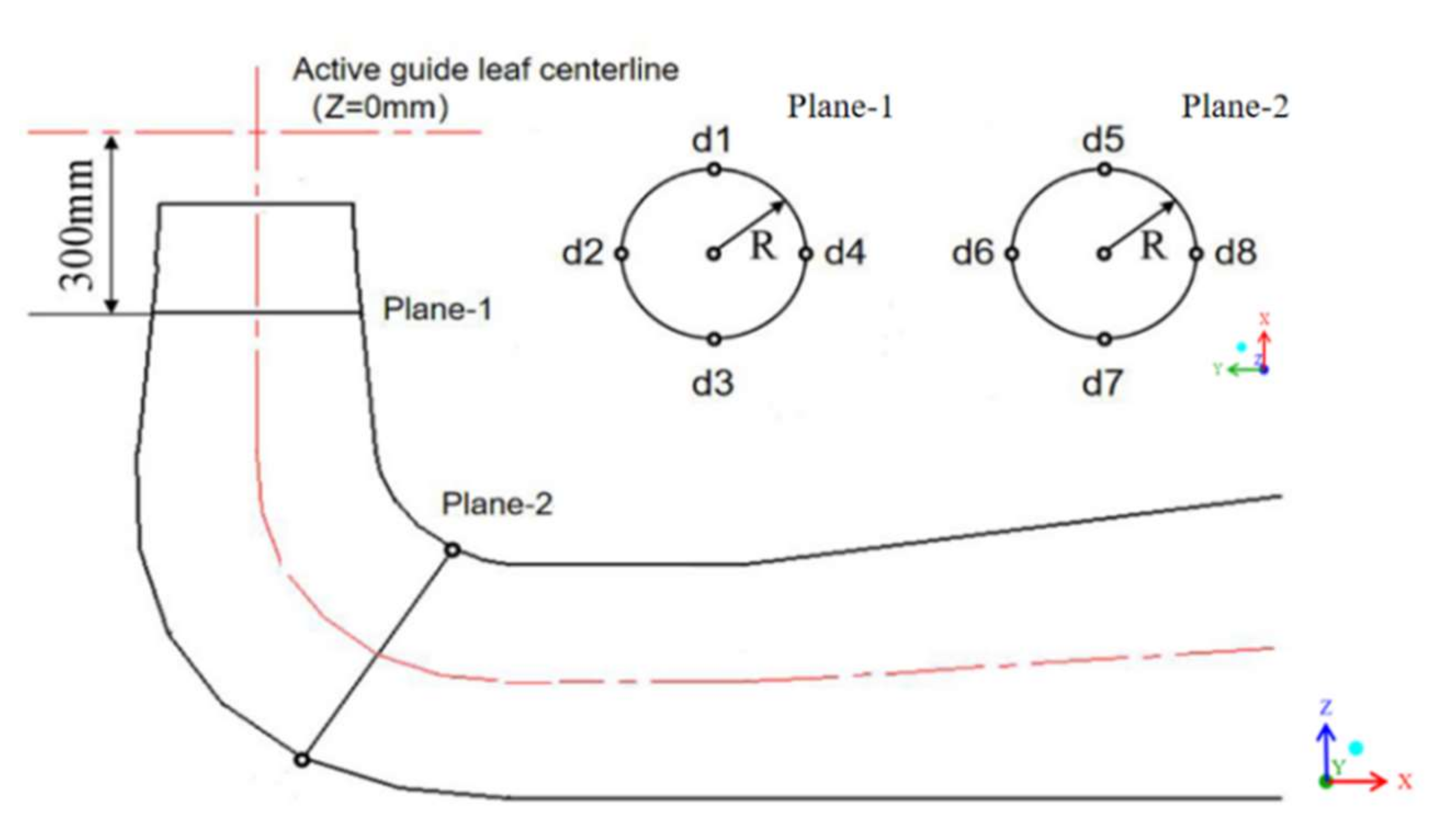
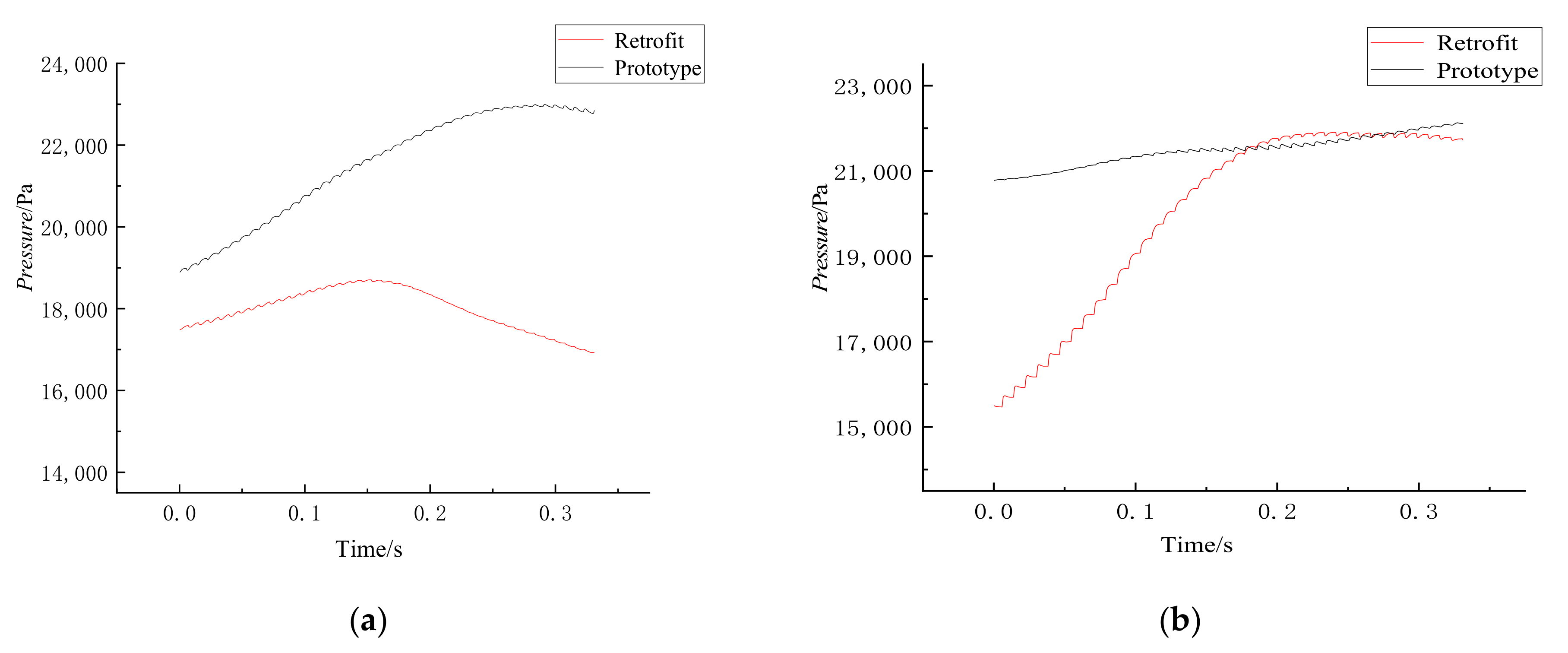


| Parameter Symbols | Numerical Values (mm) | Parameter Symbols | Numerical Values (mm) |
|---|---|---|---|
| D0 | 638.639 | e | 9.271275397 |
| a | 11.06607099 | e1 | 8.236239902 |
| a1 | 2.851853121 | d0 | 16.09810526 |
| b | 11.29730233 | m | 7.465468788 |
| b1 | 5.021023256 | m1 | 5.890893513 |
| c | 11.16517013 | k | 0.902903304 |
| c1 | 6.815818849 | f | 4.71271481 |
| d | 10.2842886 | r | 6.012014688 |
| d1 | 7.718722154 | L | 89.96 |
| L1 | 47.34736842 | L2 | 42.61263158 |
| Parameter Name | Numerical Value |
|---|---|
| Number of blades/pc | 9 |
| Active guide leaf/pc | 20 |
| Rotor high-pressure side diameter/mm | 473.6 |
| Spiral casing inlet diameter/mm | 315 |
| Height of guide lobe b0/mm | 66.72 |
| Number of fixed guide vane/pc | 20 |
| Height of guide leaf/mm | 66.72 |
| Rotor low-pressure side diameter/mm | 300 |
| Draft tube outlet diameter/mm | 660 |
| Flow rate Q11 (m3·s−1) | 0.84 | 0.83 | 0.76 | 0.66 | 0.54 | 0.3 | 0.02 |
| Speed n11 (r·min−1) | 51.2001 | 56.8747 | 65.6563 | 70.8762 | 72.3342 | 70.4606 | 65.4471 |
| Monitor the Location | f (Hz) | fn (Hz) | ΔH·H−1 (%) | f·fn−1 |
|---|---|---|---|---|
| Upstream of the spinal canal | 3.43 | 19.53 | 3.44 | 0.24 |
| Downstream of the spinal canal | 3.43 | 19.53 | 2.42 | 0.24 |
| Inside the elbow tube | 5.57 | 19.52 | 3.95 | 0.26 |
| The outside of the elbow tube | 37.6 | 19.53 | 1.9 | 1.98 |
| Location of Measurement Points | Operating Conditions | Test Results (ΔH·H−1) | Guaranteed Value (ΔH·H−1) |
|---|---|---|---|
| Spiral case import import | At rated operating conditions Partial working conditions operation | 2.02 2.14 | <3% <3% |
| Movable guide vane— between runners | At rated operating conditions Partial working conditions operation | 2.64 5.76 | <7% <7% |
| Between top cover and runner | At rated operating conditions Partial-load or no-load operation | 3.45 5.22 | <7% <7% |
| Draft tube | Optimum operating conditions Partial-load or no-load operation | 1.10 6.39 | <2% <7% |
| Before Modification | ||
|---|---|---|
| Working Conditions Q11 (m3·s−1) | (−) | (−) |
| 0.83 | 0.510515 | 0.691242 |
| 0.66 | 0.387664 | 0.729541 |
| 0.3 | 0.306514 | 0.759853 |
| After Modification | ||
| Working Conditions Q11 (m3·s−1) | (−) | (−) |
| 0.83 | 0.551535 | 0.698520 |
| 0.66 | 0.397112 | 0.738467 |
| 0.3 | 0.329992 | 0.761053 |
Publisher’s Note: MDPI stays neutral with regard to jurisdictional claims in published maps and institutional affiliations. |
© 2022 by the authors. Licensee MDPI, Basel, Switzerland. This article is an open access article distributed under the terms and conditions of the Creative Commons Attribution (CC BY) license (https://creativecommons.org/licenses/by/4.0/).
Share and Cite
Li, Q.; Xin, L.; Xie, G.; Liu, S.; Wang, Q. Influence of Guide Vane Profile Change on Draft Tube Flow Characteristics of Water Pump Turbine. Processes 2022, 10, 1494. https://doi.org/10.3390/pr10081494
Li Q, Xin L, Xie G, Liu S, Wang Q. Influence of Guide Vane Profile Change on Draft Tube Flow Characteristics of Water Pump Turbine. Processes. 2022; 10(8):1494. https://doi.org/10.3390/pr10081494
Chicago/Turabian StyleLi, Qifei, Lu Xin, Gengda Xie, Siqi Liu, and Qifan Wang. 2022. "Influence of Guide Vane Profile Change on Draft Tube Flow Characteristics of Water Pump Turbine" Processes 10, no. 8: 1494. https://doi.org/10.3390/pr10081494





